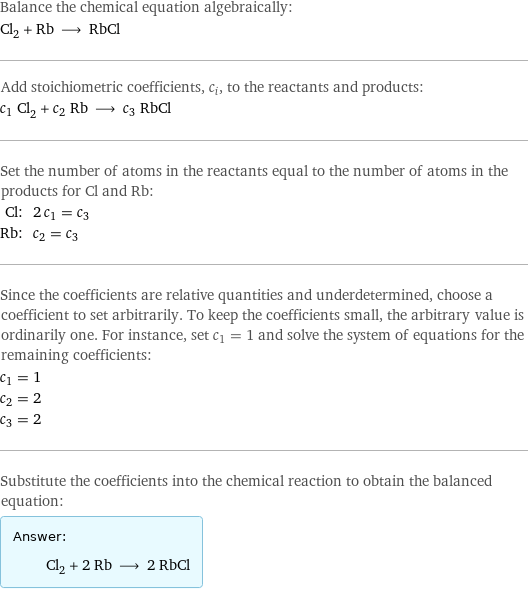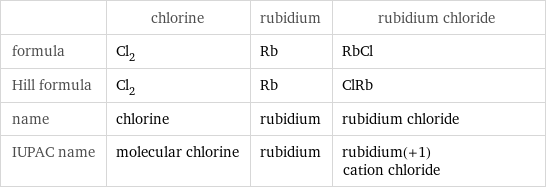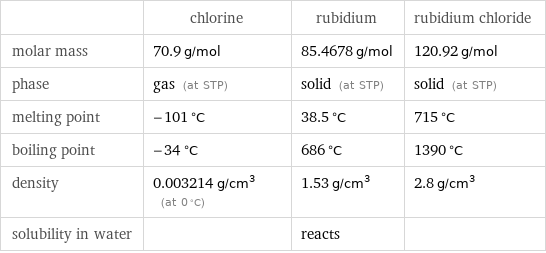Input interpretation

Cl_2 chlorine + Rb rubidium ⟶ RbCl rubidium chloride
Balanced equation

Balance the chemical equation algebraically: Cl_2 + Rb ⟶ RbCl Add stoichiometric coefficients, c_i, to the reactants and products: c_1 Cl_2 + c_2 Rb ⟶ c_3 RbCl Set the number of atoms in the reactants equal to the number of atoms in the products for Cl and Rb: Cl: | 2 c_1 = c_3 Rb: | c_2 = c_3 Since the coefficients are relative quantities and underdetermined, choose a coefficient to set arbitrarily. To keep the coefficients small, the arbitrary value is ordinarily one. For instance, set c_1 = 1 and solve the system of equations for the remaining coefficients: c_1 = 1 c_2 = 2 c_3 = 2 Substitute the coefficients into the chemical reaction to obtain the balanced equation: Answer: | | Cl_2 + 2 Rb ⟶ 2 RbCl
Structures

+ ⟶
Names

chlorine + rubidium ⟶ rubidium chloride
Reaction thermodynamics
Enthalpy

| chlorine | rubidium | rubidium chloride molecular enthalpy | 0 kJ/mol | 0 kJ/mol | -435.4 kJ/mol total enthalpy | 0 kJ/mol | 0 kJ/mol | -870.8 kJ/mol | H_initial = 0 kJ/mol | | H_final = -870.8 kJ/mol ΔH_rxn^0 | -870.8 kJ/mol - 0 kJ/mol = -870.8 kJ/mol (exothermic) | |
Equilibrium constant
![Construct the equilibrium constant, K, expression for: Cl_2 + Rb ⟶ RbCl Plan: • Balance the chemical equation. • Determine the stoichiometric numbers. • Assemble the activity expression for each chemical species. • Use the activity expressions to build the equilibrium constant expression. Write the balanced chemical equation: Cl_2 + 2 Rb ⟶ 2 RbCl Assign stoichiometric numbers, ν_i, using the stoichiometric coefficients, c_i, from the balanced chemical equation in the following manner: ν_i = -c_i for reactants and ν_i = c_i for products: chemical species | c_i | ν_i Cl_2 | 1 | -1 Rb | 2 | -2 RbCl | 2 | 2 Assemble the activity expressions accounting for the state of matter and ν_i: chemical species | c_i | ν_i | activity expression Cl_2 | 1 | -1 | ([Cl2])^(-1) Rb | 2 | -2 | ([Rb])^(-2) RbCl | 2 | 2 | ([RbCl])^2 The equilibrium constant symbol in the concentration basis is: K_c Mulitply the activity expressions to arrive at the K_c expression: Answer: | | K_c = ([Cl2])^(-1) ([Rb])^(-2) ([RbCl])^2 = ([RbCl])^2/([Cl2] ([Rb])^2)](../image_source/664e6dad9486582909f9f59fc9382282.png)
Construct the equilibrium constant, K, expression for: Cl_2 + Rb ⟶ RbCl Plan: • Balance the chemical equation. • Determine the stoichiometric numbers. • Assemble the activity expression for each chemical species. • Use the activity expressions to build the equilibrium constant expression. Write the balanced chemical equation: Cl_2 + 2 Rb ⟶ 2 RbCl Assign stoichiometric numbers, ν_i, using the stoichiometric coefficients, c_i, from the balanced chemical equation in the following manner: ν_i = -c_i for reactants and ν_i = c_i for products: chemical species | c_i | ν_i Cl_2 | 1 | -1 Rb | 2 | -2 RbCl | 2 | 2 Assemble the activity expressions accounting for the state of matter and ν_i: chemical species | c_i | ν_i | activity expression Cl_2 | 1 | -1 | ([Cl2])^(-1) Rb | 2 | -2 | ([Rb])^(-2) RbCl | 2 | 2 | ([RbCl])^2 The equilibrium constant symbol in the concentration basis is: K_c Mulitply the activity expressions to arrive at the K_c expression: Answer: | | K_c = ([Cl2])^(-1) ([Rb])^(-2) ([RbCl])^2 = ([RbCl])^2/([Cl2] ([Rb])^2)
Rate of reaction
![Construct the rate of reaction expression for: Cl_2 + Rb ⟶ RbCl Plan: • Balance the chemical equation. • Determine the stoichiometric numbers. • Assemble the rate term for each chemical species. • Write the rate of reaction expression. Write the balanced chemical equation: Cl_2 + 2 Rb ⟶ 2 RbCl Assign stoichiometric numbers, ν_i, using the stoichiometric coefficients, c_i, from the balanced chemical equation in the following manner: ν_i = -c_i for reactants and ν_i = c_i for products: chemical species | c_i | ν_i Cl_2 | 1 | -1 Rb | 2 | -2 RbCl | 2 | 2 The rate term for each chemical species, B_i, is 1/ν_i(Δ[B_i])/(Δt) where [B_i] is the amount concentration and t is time: chemical species | c_i | ν_i | rate term Cl_2 | 1 | -1 | -(Δ[Cl2])/(Δt) Rb | 2 | -2 | -1/2 (Δ[Rb])/(Δt) RbCl | 2 | 2 | 1/2 (Δ[RbCl])/(Δt) (for infinitesimal rate of change, replace Δ with d) Set the rate terms equal to each other to arrive at the rate expression: Answer: | | rate = -(Δ[Cl2])/(Δt) = -1/2 (Δ[Rb])/(Δt) = 1/2 (Δ[RbCl])/(Δt) (assuming constant volume and no accumulation of intermediates or side products)](../image_source/f077b0ef0fed84df1c0e2546e92e6b2c.png)
Construct the rate of reaction expression for: Cl_2 + Rb ⟶ RbCl Plan: • Balance the chemical equation. • Determine the stoichiometric numbers. • Assemble the rate term for each chemical species. • Write the rate of reaction expression. Write the balanced chemical equation: Cl_2 + 2 Rb ⟶ 2 RbCl Assign stoichiometric numbers, ν_i, using the stoichiometric coefficients, c_i, from the balanced chemical equation in the following manner: ν_i = -c_i for reactants and ν_i = c_i for products: chemical species | c_i | ν_i Cl_2 | 1 | -1 Rb | 2 | -2 RbCl | 2 | 2 The rate term for each chemical species, B_i, is 1/ν_i(Δ[B_i])/(Δt) where [B_i] is the amount concentration and t is time: chemical species | c_i | ν_i | rate term Cl_2 | 1 | -1 | -(Δ[Cl2])/(Δt) Rb | 2 | -2 | -1/2 (Δ[Rb])/(Δt) RbCl | 2 | 2 | 1/2 (Δ[RbCl])/(Δt) (for infinitesimal rate of change, replace Δ with d) Set the rate terms equal to each other to arrive at the rate expression: Answer: | | rate = -(Δ[Cl2])/(Δt) = -1/2 (Δ[Rb])/(Δt) = 1/2 (Δ[RbCl])/(Δt) (assuming constant volume and no accumulation of intermediates or side products)
Chemical names and formulas

| chlorine | rubidium | rubidium chloride formula | Cl_2 | Rb | RbCl Hill formula | Cl_2 | Rb | ClRb name | chlorine | rubidium | rubidium chloride IUPAC name | molecular chlorine | rubidium | rubidium(+1) cation chloride
Substance properties

| chlorine | rubidium | rubidium chloride molar mass | 70.9 g/mol | 85.4678 g/mol | 120.92 g/mol phase | gas (at STP) | solid (at STP) | solid (at STP) melting point | -101 °C | 38.5 °C | 715 °C boiling point | -34 °C | 686 °C | 1390 °C density | 0.003214 g/cm^3 (at 0 °C) | 1.53 g/cm^3 | 2.8 g/cm^3 solubility in water | | reacts |
Units
